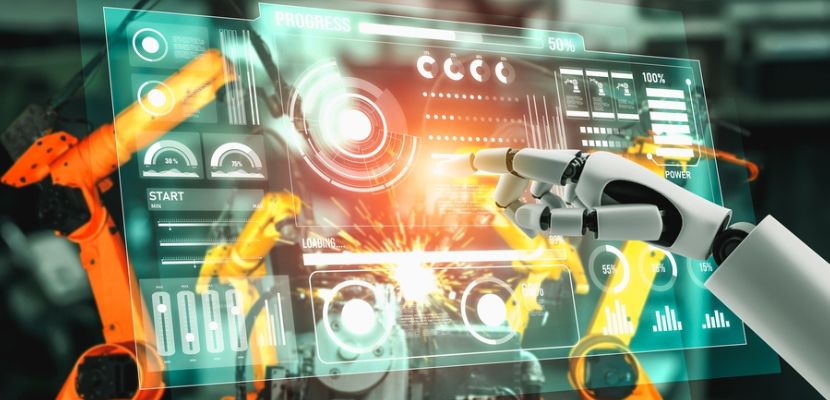Robotic Process Automation (RPA) automates repetitive tasks using software robots, enhancing efficiency, accuracy, and productivity in business processes.

What Is Robotic Process Automation (RPA)?
Robotic process automation (RPA) is a technology that utilizes software robots or 'bots' to automate highly repetitive, routine tasks that human workers traditionally perform. These bots mimic human actions such as logging into applications, entering data, calculating and completing tasks, and even communicating with other digital systems.
RPA is designed to streamline operations, reduce costs, and improve accuracy by eliminating the potential for human error. It integrates with existing systems without requiring significant changes to the underlying IT infrastructure, making it a versatile solution for various industries. The primary aim of RPA is to free up human employees to focus on more strategic, value-added activities while the bots handle the mundane, time-consuming tasks.
A Short History of Robotic Process Automation
Robotic process automation has its roots in early automation technologies and evolved through several key phases. Initially, screen scraping and workflow automation tools emerged in the late 1990s and early 2000s, allowing basic task automation. In the mid-2000s, advancements in artificial intelligence and machine learning laid the groundwork for more sophisticated automation.
By the early 2010s, RPA began to gain traction as companies like Blue Prism, UiPath, and Automation Anywhere introduced robust platforms capable of mimicking human actions in business processes. RPA quickly grew in popularity across various industries, driven by its potential to enhance efficiency, reduce costs, and improve accuracy. Today, RPA continues to evolve, incorporating advanced cognitive capabilities and expanding its applications beyond simple rule-based tasks to more complex, decision-based processes.
How Does RPA Work?

Robotic process automation works by automating repetitive, rule-based tasks through software robots. Here's an explanation of the steps involved in the RPA process:
- Identify tasks for automation. The first step is to identify and analyze the tasks or processes suitable for automation. These tasks are typically repetitive, rule-based, and involve structured data.
- Design the automation workflow. Once the tasks are identified, a detailed workflow is designed. This workflow outlines the steps the software robot will take to complete the tasks. The design includes data inputs, processing rules, and outputs.
- Develop the robot. Using an RPA tool, developers create the software robot. This involves configuring the bot to interact with various applications, input data, perform calculations, and execute commands as defined in the workflow.
- Test the robot. Before deploying the robot, it's tested in a controlled environment to ensure it performs the tasks accurately and efficiently. Any errors or issues are identified and resolved during this phase.
- Deploy the robot. After successful testing, the robot is deployed to the live environment. It starts performing the automated tasks as per the designed workflow, interacting with applications just like a human would.
- Monitor and maintain. Once the robot is operational, its performance is continuously monitored to ensure it functions correctly. Regular maintenance and updates are performed to adapt to any changes in the underlying applications or processes.
- Scale and optimize. As the organization gains confidence in RPA, more processes can be automated. Optimization techniques are applied to improve the efficiency and effectiveness of the automation, potentially incorporating advanced features like artificial intelligence for more complex tasks.
Robotic Process Automation Use Cases
Robotic process automation is transforming various industries by automating repetitive and rule-based tasks, thereby enhancing efficiency and accuracy. Here are some common use cases of RPA:
- Data entry and data migration. RPA automates entering data into systems and migrating it between different applications. This reduces errors and speeds up processes that would otherwise be time-consuming if done manually.
- Invoice processing. In finance departments, RPA bots handle invoice processing by extracting data from invoices, validating it, and entering it into the accounting system. This streamlines the accounts payable process and ensures timely payments.
- Customer service and support. RPA automates responses to common inquiries, processes service requests, and updates customer information in CRM systems. This allows human agents to focus on more complex customer issues.
- Payroll processing. RPA manages payroll tasks such as calculating wages, deducting taxes, and distributing payments. It ensures accuracy and compliance with regulations, reducing the administrative burden on HR departments.
- Order processing and inventory management. In supply chain operations, RPA automates order processing, inventory updates, and stock level monitoring. This enhances accuracy and efficiency in managing inventory and fulfilling orders.
- Regulatory compliance. RPA helps to ensure compliance with regulations by automating the monitoring and reporting of compliance-related activities, including data collection, validation, and report generation.
- Claims processing. In the insurance industry, RPA expedites claims processing by automating data extraction from claim forms, validating information, and processing claims for approval or denial.
- IT support and management. RPA automates routine IT tasks such as password resets, system updates, and user account management. This frees up IT staff to focus on more strategic initiatives and complex problem-solving.
Robotic Process Automation Benefits and Challenges
Robotic process automation offers numerous advantages, such as improved efficiency and reduced operational costs, but it also presents certain challenges that organizations must address. Understanding both the benefits and challenges of RPA is crucial for successful implementation and maximizing its potential impact.
RPA Benefits
Robotic process automation provides a range of benefits that enhance business operations and overall efficiency. Here are some key benefits:
- Increased efficiency. RPA automates repetitive and time-consuming tasks, allowing them to be completed faster and more accurately than manual processing.
- Cost savings. By automating routine tasks, RPA reduces the need for manual labor, resulting in substantial cost savings.
- Improved accuracy. RPA bots follow predefined rules and processes without deviation, minimizing the risk of human errors.
- Scalability. Organizations can deploy additional bots to handle increased workloads or scale back during periods of lower demand without significant additional costs.
- Enhanced compliance. Bots can be programmed to maintain detailed logs and audit trails, facilitating compliance with industry standards and regulations.
- Better customer experience. By automating routine customer service tasks, RPA allows human agents to focus on more complex and personalized interactions.
- Increased employee satisfaction. Automating mundane and repetitive tasks frees employees from monotonous work, allowing them to engage in more meaningful and challenging activities.
- Quick implementation. RPA solutions can be implemented relatively quickly, enabling organizations to realize the benefits of automation in a short timeframe.
RPA Challenges
Implementing robotic process automation can bring substantial benefits, but it also comes with its own set of challenges. Here are some common challenges associated with RPA:
- Complexity in implementation. RPA implementation can be complex, requiring significant planning, resources, and technical expertise. Organizations may face difficulties in designing, developing, and deploying bots effectively.
- Integration with existing systems. Integrating RPA with existing IT infrastructure and legacy systems can be challenging. Compatibility issues and the need for custom integration solutions complicate the process.
- Change management. Adopting RPA often requires changes in workflows and employee roles. Resistance to change from employees and stakeholders hinders the successful implementation and adoption of RPA.
- Maintenance and scalability. Once deployed, RPA bots require regular maintenance and updates to adapt to changes in the underlying applications and processes. Scaling RPA across the organization can also be challenging without robust governance and management practices.
- Security and compliance. Ensuring that RPA solutions comply with security standards and regulatory requirements is critical. Organizations must address potential security vulnerabilities and ensure that bots handle sensitive data appropriately.
- Process standardization. For RPA to be effective, processes need to be well-defined and standardized. Inconsistent or poorly documented processes lead to errors and inefficiencies in automation.
- Initial costs and ROI. The initial costs of implementing RPA, including software licensing, development, and training, can be high. Achieving a positive return on investment may take time, and organizations need to carefully assess the financial impact.
How to Choose an RPA Solution?
Choosing the right robotic process automation solution involves several critical considerations to ensure it aligns with your organization's needs and goals. Here are key factors to consider:
- Identify business needs. Assess the specific processes and tasks you want to automate. Understand the scope, complexity, and volume of these tasks to determine the requirements for an RPA solution.
- Evaluate vendor capabilities. Research and compare RPA vendors based on their features, functionalities, and industry reputation. Look for vendors with a proven track record, strong customer support, and continuous innovation in their offerings.
- Scalability and flexibility. Choose an RPA solution that can scale with your organization's growth and adapt to changing business needs. Ensure the solution can handle increasing volumes of transactions and can be easily modified to automate new processes.
- Ease of use and implementation. Opt for a user-friendly RPA tool with a straightforward implementation process. A solution with a low-code or no-code interface allows business users to design and deploy bots without extensive technical expertise.
- Integration capabilities. Ensure the RPA solution can seamlessly integrate with your existing IT infrastructure, applications, and systems. This includes compatibility with various software, databases, and APIs.
- Security and compliance. Prioritize RPA solutions that offer robust security features and comply with industry standards and regulations. This is crucial to protect sensitive data and maintain regulatory compliance.
- Cost and ROI. Consider the total cost of ownership, including licensing fees, implementation costs, and ongoing maintenance. Calculate the anticipated cost savings and efficiency gains to evaluate the potential return on investment.
- Support and training. Choose a vendor that provides comprehensive support, including technical assistance, training resources, and a strong user community. This ensures your team can effectively utilize the RPA solution and troubleshoot issues as they arise.
- Pilot testing. Before fully committing, conduct a pilot test of the RPA solution on a small scale to evaluate its performance, ease of use, and effectiveness in automating your target processes. Use the results to make an informed decision.